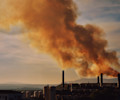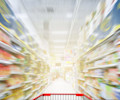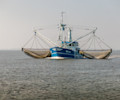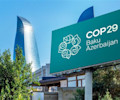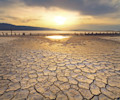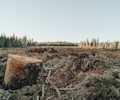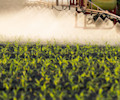Climate-related cost rises could wipe out 2020-level profits for 20/40 of the largest listed livestock companies unless new strategies are urgently adopted, according to new IPCC-aligned climate risk analysis tool for investors
FAIRR’s Climate Risk Tool estimates a $23.7bn total decrease in EBIT in 2030 compared to 2020 levels for 40 of the largest livestock producers – pushing 20 into net operating losses. This comes as the recent IPCC synthesis report warns that 1.5°C of warming is now ‘more likely than not’.
Companies at risk of losses include JBS (Brazil), Tyson Foods (US), WH Group (China), and Cal-Maine (US), with North America the region hardest hit with companies seeing profit margins fall by 11% on average.
Just 6/40 companies have carried out a climate scenario analysis, leaving them underprepared for cost increases driven by a climate-related surge in feed prices, and expected carbon taxes.
FAIRR’s latest report calls on companies to disclose information on climate scenario analysis, and to develop more robust climate mitigation and adaptation strategies.
“The allure of investing in meat and dairy could be approaching expiration unless companies take action to address climate change”
Jeremy Coller, Chair of $70 trillion FAIRR investor network.
(London, 28/3/23) The FAIRR Initiative, the world’s fastest-growing ESG investor network representing over $70tn in combined assets, today launched an enhanced iteration of its Coller FAIRR Climate Risk Tool providing investors with company-level data on how climate risks may impact costs and profitability in the meat and dairy sector.
In 2030, in FAIRR’s 2°C ‘Business as Usual’ scenario1, 40 livestock companies would suffer a 7% reduction in profit margins2 on average compared to 2020 levels, representing $23.7bn overall. This is equivalent to over four times Tyson Foods’ 2022 profits. Under this scenario and without mitigations, 20 companies, including JBS, Tyson Foods and WH Group (owners of Smithfield), would be operating at a loss. All figures, including cost rises and profit reductions, are calculated compared to 2020 levels.
FAIRR’s ‘Business as Usual’ scenario uses the IPCC’s ‘middle of the road’ shared socioeconomic pathway, projecting revenue growth assuming current trends of meat and dairy consumption continue as the population grows to 9.2 billion people by 2050. It models climate impacts, for example on agricultural productivity, in line with a 2°C global temperature rise by 2100. This scenario is realistic given the warning in the IPCC’s report this month that global temperatures are likely to reach 1.5C above pre-industrial levels in the near-term, with carbon emissions continuing to rise. The model has been created by FAIRR in partnership with IPCC scientists.
Potential hits to profits are driven largely by an increase in climate-related costs which are forecast to rise by over 9% on average. Climate change will impact agricultural production, contributing to higher feed prices which account for 5% of the cost rise, with expected carbon taxes on emissions from livestock production making up 4%3.
FAIRR’s model has factored in companies’ potential to offset cost increases through the climate mitigation strategies they have publicly disclosed. Yet, only 11/40 companies disclose how they plan to mitigate risks from rising feed costs through either data tracking, sourcing diversification or substituting alternative feed ingredients. Just 6/40 companies have published a climate scenario analysis, widely regarded as a useful tool for planning effective climate risk mitigation strategies. Future profitability will be dependent on companies mitigating these risks or may lead to passing costs on. This could mean narrower margins for suppliers, or higher prices for customers and consumers.
In 2030, profits could fall by $23.7bn compared to 2020 levels driven primarily by feed price rises
At the regional level, North American companies would be the hardest hit – seeing profit margins fall by 11% on average in 2030 compared to 2020 levels amongst the 6 companies analysed, driven by a 15% average cost increase. Rising feed prices would be the biggest contributor as market- and climate-related impacts on feed crops in the region bite, accounting for 14% of the cost rise on average.
US beef, pork and poultry producer Tyson Foods could see profits fall by over $4.3bn in 2030 compared to 2020, meaning it would operate at a net loss compared to 2020 levels with a profit margin of negative 0.9%. Its decline in profitability in this scenario would be driven by a 10% increase in costs from rising feed prices and a 5% increase from an expected carbon tax unless mitigation strategies are urgently adopted. The ongoing drought in the US Midwest has already contributed to rising feed costs, with Tyson reporting that feed represented 62% of the cost of rearing a chicken in 2022, up from 59% in 2021. Its operating profit in the fiscal year 2022 was impacted by $595 million of higher feed costs.
The largest egg producer in the US, Cal-Maine, would see a 15% cost increase from rising feed prices in 2030 – contributing to a $354mn hit to profits, and a profit margin of negative 13.1%. Cal-Maine reports that feed accounted for 62% of total farm production costs in 2022, up from 58% the year before. The model does not take into account the impact of external factors such as the ongoing circulation of bird flu, which has led to the deaths of over 58 million poultry in the US alone since the start of 2022.
Differences in cost estimates are due to differing impacts of carbon taxes and feed prices dependant on companies’ protein and regional exposure. Pigs and chickens are more reliant on feed in production than cows. Cows are the highest emitting livestock, so companies producing beef and dairy are more exposed to carbon taxes. Regionally, climate impacts on feed prices will differ, and some regions are expected to introduce carbon taxes before others and at different rates.
Brazilian beef supplier JBS would see profits fall by $5bn, operating at a negative 0.3% profit margin, with cost increases driven by carbon tax (8%) and feed price rises (7%). Chinese pork producer WH Group’s profits would be reduced by $2.5bn, with a negative 2.7% profit margin, with cost increases driven by feed prices (11%), with just a 1% increase due to carbon tax.
Jeremy Coller, Chair and Founder of FAIRR, and Chief Investment Officer of Coller Capital, said:
“As investors start to factor climate risk into their long-term valuations of livestock companies, the allure of investing in meat and dairy could be approaching an expiration date unless companies take action to address climate risk. These figures highlight the urgent need for meat companies to adapt swiftly, or pay the financial price with investors increasingly not willing to bear the financial risk of investing in these companies.
“To mitigate the clear risk to the bottom line, companies should take a scientific approach and explore the best available strategies, including diversifying products and portfolios towards plant-based alternatives.”
Tovia Rosner, Portfolio Analyst at Allianz Global Investors, said,
“FAIRR’s new Climate Risk Tool sets a new standard for assessing climate risk in the food industry, providing investors with better insights into material risks faced by companies. This data will further strengthen our engagements with companies on climate mitigation and adaptation strategies by showing additional proof points and ultimately helping us to hold companies accountable. Data on how rising feed prices and carbon taxes may impact the profitability of global meat and dairy companies is important for financial institutions working to ensure robust and resilient portfolios”.
Rebecca White, CFA, Responsible Investment at Newton Investment Management, said:
“There is increasing recognition that climate-related risks can have a financially material impact on companies. However, it can be challenging to analyse such risks, in part given the complexity and uncertainty in climate science, and difficult to gauge their investment implications. FAIRR’s climate-risk model should help investors to integrate the risks into investment decisions and stewardship activities, through the lens of physical and transition risks. This is particularly important for companies linked to animal agriculture, which tend to have material risk exposures.”
Stefan Frank, Senior Research Scholar at International Institute for Applied Systems Analysis (IIASA), said:
"The livestock sector must undergo a radical transformation to reduce emissions intensities and mitigate the well-known environmental and climate impacts of production. The faster and more ambitious we act now, the smoother the transition can be."
Philip Thornton, International Livestock Research Institute Emeritus Fellow, and Working Group II Lead Author for the IPCC’s Sixth Assessment Report, said:
“This climate risk model represents a significant step forward in modelling the economic costs of a warming world on livestock producers. Partnered with IIASA, which helped build the scenarios used by the IPCC in its most recent AR6 reports and in this new model, FAIRR has produced a model that sheds new light on the complex relationship between the likely future economics of livestock production and climate change.
“As set out in the IPCC’s synthesis report released this week, investors, food producers and policymakers alike must take serious note of the potential for supply chain disruption caused by climate change – and take steps to mitigate the impact on global food supply. These include helping to drive a dietary shift away from excessive meat and dairy consumption in higher-income countries and ensuring that vulnerable people in lower-income countries have access to diverse, affordable, sustainable and equitable diets.”
In 2050, $38bn profit losses would be driven primarily by carbon taxes, overtaking higher feed prices as the biggest cost driver
Following this 2°C ‘Business as Usual’ scenario through to 2050, sector profits are forecast to fall by $38bn (10% fall in profit margins on average) compared to 2020 as carbon taxes overtake feed price rises as the most significant driver of cost increases. Modelling reveals an average projected cost rise of 14% across the group of 40 companies – including an 8% increase due to carbon taxes, and 5% costs from feed price rises.
Latin America (LatAm) is predicted to be the region worst affected in this scenario, with 6 companies taking total profit hit of $14bn, representing a 16% fall in profit margin on average. This is driven by an average 23% cost increase, with predicted carbon taxes driving 16% of the cost rise, and rising feed prices representing 4%.
Marfrig leading in mitigation of climate risks
The Coller FAIRR Climate Risk Tool considers companies’ ability to mitigate climate risks based on their latest disclosures on climate-related factors, as tracked by the annual Coller FAIRR Protein Producer Index.
Some companies are taking action to mitigate risks. Marfrig for example, has set an SBTi emissions reduction target, a strong deforestation target, and calculates the potential financial impact of carbon prices on their costs. These factors contribute to the potential for Marfrig to mitigate its costs – with FAIRR estimating a 13.60% cost rise in 2030 – instead of 19%, through concrete steps on climate risk management. However, even with those mitigations in place Marfrig still faces a potential $1.9 billion reduction in profits, operating at a negative profit margin of 1.9% in 2030.
Notes to Editor
1 In the FAIRR Climate Risk Model, profit is measured as earnings before interest and tax (EBIT), whilst profit margin is defined as EBIT divided by revenue. A negative profit margin means the EBIT margin is below zero, meaning the company is loss-making.
2 FAIRR’s ‘Business as Usual’ scenario is modelled using the IPCC’s shared socioeconomic pathway 2 ‘middle of the road’, projecting revenue growth assuming current trends of meat and dairy consumption are likely to continue for a growing population that will reach 9.2 billion people by 2050. FAIRR’s model for this scenario assumes moderate impacts on agricultural production from climate change and limited climate mitigation efforts, and a pathway towards a 2°C global temperature rise compared to pre-industrial levels by 2100. All figures, including cost rises and profit reductions, are calculated compared to 2020 levels.
3 Carbon price estimates come from the GLOBIOM model’s carbon price pathways attributed to land use change and agricultural production (AFOLU). FAIRR’s modelling considers scope 1 and 3 emissions. The below numbers are maximum values to developed countries (USD/ton of CO2e). Regions are grouped as ‘developing’, such as LatAm, are expected to see half the carbon tax of regions groued as ‘developed’, such as North America.
2030 | 2050 | |
|---|---|---|
High Climate Impact | 42.4 | 112.6 |
Business as Usual | 36.1 | 95.9 |
Net Zero Aligned | 20.2 | 53.6 |
Media Contact
For more information, including interviews and comments, please contact:
Mike Marshall, ESG Communications
t: + 44 (0)7728 816 426 | e: mikem@esgcomms.com
About the Coller FAIRR Climate Risk Tool
The Coller FAIRR Climate Risk Tool is powered by the Coller FAIRR Climate Risk Model. The model is built using the latest and best available science, aligned with the most recent scenarios from the Intergovernmental Panel on Climate Change (IPCC) and Network for Greening the Financial System (NGFS) and produced in collaboration with the International Institute for Applied Systems Analysis (IIASA).
The underlying model outputs used to inform the tool comes from an integrated economic land use model (GLOBIOM), used in impact assessment modelling, to examine the impacts of forward-looking socioeconomic trends, climate change, and environmental policies to quantify the financial risks and opportunities most material to the biggest livestock companies under three IPCC global warming scenarios, supplemented by data from the latest company disclosures. The tool provides insights into climate risk in 2030 and 2050.
Estimates of future company profits are made using GLOBIOM’s scenario-based projections of global meat and dairy consumption, carbon prices and feed prices, together with individual companies’ potential to mitigate costs according to current company disclosures as tracked by the 2022 Coller FAIRR Protein Producer Index. Whilst the model does account for cost inflation, it doesn’t assume cost pass-through.
Companies fair considerably worse in FAIRR’s >2°C ‘High Climate Impact’ scenario, and better in a cooler 1.5°C ‘Net Zero’ world. A report accompanying the launch explores the model with examples from the >2°C scenario.
The 40 companies modelled are: Almarai Co JSC, Astral Foods Ltd, Australian Agricultural Co Ltd, Beijing Sanyuan Foods Co Ltd, Bell Food Group AG, BRF SA, Cal-Maine Foods Inc, Charoen Pokphand Foods PCL, Cherkizovo Group PJSC, China Mengniu Dairy Co Ltd, China Modern Dairy Holdings Ltd, COFCO Joycome Foods Ltd, Cranswick PLC, Emmi AG, Fonterra Co-operative Group Ltd, Fujian Sunner Development Co Ltd, GFPT PCL, Grupo Bafar SAB de CV, Hormel Foods Corp, Industrias Bachoco SAB de CV, Inghams Group Ltd, Inner Mongolia Yili Industrial Group Co Ltd, Japfa Ltd, JBS S.A., LDC SA, Maple Leaf Foods Inc, Marfrig Global Foods SA, MHP SE, Minerva SA, Muyuan Foodstuff Co Ltd, NH Foods Ltd, Prima Meat Packers Ltd, Sanderson Farms Inc, Scandi Standard AB, Thaifoods Group PCL, Tyson Foods Inc, Vietnam Dairy Products JSC, Vital Farms, Wens Foodstuff Group Co., Ltd., WH Group Ltd
About FAIRR
The FAIRR Initiative is a collaborative investor network, founded by Jeremy Coller, with a membership of $70 trillion in collective assets of support. FAIRR works with institutional investors to define the material ESG issues linked to intensive livestock and fish farming systems and provide them with the tools necessary to integrate this information into their asset stewardship and investment decisions. This includes the Coller FAIRR Index, the world’s first comprehensive assessment of the largest global animal protein companies on environmental, social and governance issues. Visit www.fairr.org and follow @FAIRRInitiative.

